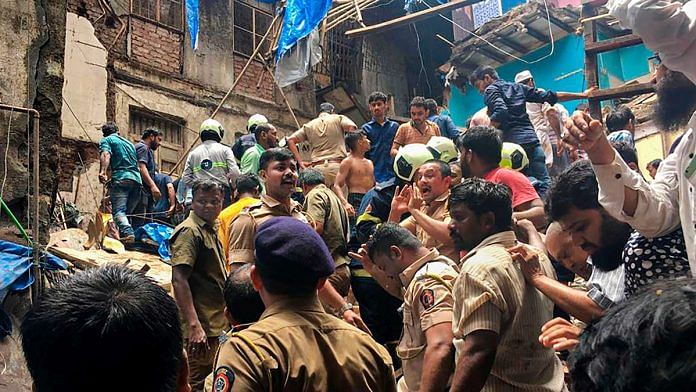Mumbai: Twelve persons were killed after a four-storey residential building collapsed in south Mumbai’s congested Dongri area Tuesday, trapping over 40 people under the debris, civic officials said.
Twelve people were killed after the ‘Kausarbaug’ building, located in a bustling narrow lane in Tandel Street of Dongri area of south Mumbai, crashed, housing minister Radhakrishna Vikhe Patil said.
A BMC official said seven persons were injured in the collapse.
Mumbai mayor Vishwanath Mahadeshwar said he has asked the municipal commissioner to launch a probe in the incident.
TV channels showed dramatic visuals of a child, wrapped in a cloth bundle, being carried out of the debris by rescue workers. The child is alive, officials said.
The Brihanmumbai Municipal Corporation (BMC) has opened a shelter at Imamwada Municipal Secondary Girls’ School after the building collapse, a civic official said.
“A team of the National Disaster Response Force (NDRF) is reaching the spot. We are assuming that 10 to 12 families are still under the debris,” Mumbadevi MLA Amin Patel told reporters at the spot.
Chief Minister Devendra Fadnavis said the building was around 100 years old. It was not in the list of dilapidated buildings and was given to a developer for redevelopment.
Between 10 to 15 families lived in the building, he said.
Locals said the building belonged to the Maharashtra Housing and Area Development Authority (MHADA). However, Vinod Ghosalkar, chief of MHADA repair board, said the building did not belong to the housing body.
Legislator Bhai Jagtap said residents had complained to housing authorities to take prompt measures as the building was very old and in a dilapidated state for a long time.
Some part of the building was left standing after the collapse.
Fire brigade, Mumbai Police and civic officials rushed to the site but the constricted lanes made it difficult to access the area, reduced to a mass of rubble, twisted concrete and broken wires.
Scores of locals joined in the effort, forming a human chain to help in removing the debris brick by brick and picking up slabs of concrete to locate those buried.
Ambulances could not reach the site and had to be parked around 50 metres away.
Mumbai Police Commissioner Sanjay Barve visited the site of the building collapse.
The rescue work, which was hampered by narrow lanes, was further delayed as politicians, including ministers, legislators and leader of opposition, made a beeline to the building collapse site.
Also read: Mumbai struggles with heaviest monsoon downpour since 2005







The root cause of this failure is our legal framework. Tenancy laws ensured that the property could never be transferred but a ‘pagdi’ was given to keep the nominal rent. Meanwhile, nobody wants to fix the building – the landlord because all they get is a nominal rent and the tenants who don’t have the actual papers. So, the buildings fall apart. The unreformed judicial system with its interminable delays ensures that rental market is virtually non-existent and so people living in dilapidated buildings have no where to go either. There will be much finger pointing but the failure is systemic. But who will blame our legal system for murder?
Tragic. The average age of these buildings is one hundred years. The process of their reconstruction is taking too long. In the meantime, the Repair Board of MHADA does the best it can in very trying circumstances.